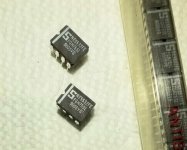I have Signetics 5534's from 1979 and 1980, but these are the earliest ones I've seen from another maker. But whose logo is on these? Is it Raytheon's? I believe they started second-sourcing the 5534 in '78 or '79.

OK, yes, I see you are correct. I had no idea they made 5534's, let alone in 1981... and I find no reference to it online.
OK, I see it now. I guess it would help if I let Google search on more than one website 🙁
It seems Exar did not stay with that product line for very long. These were pulled from an HP modulation analyzer.
It seems Exar did not stay with that product line for very long. These were pulled from an HP modulation analyzer.
Exar (founded by former employees of Raytheon, hence ex-R) manufactured the RC4136 quad opamps we found within my roommate's Phase Linear preamp. Yes, the 4136 was originally a Raytheon part.
Exar (founded by former employees of Raytheon, hence ex-R)
An "Aha!" moment 🙂
Aye, I've encountered those.manufactured the RC4136 quad opamps we found within my roommate's Phase Linear preamp. Yes, the 4136 was originally a Raytheon part.
Exar was whip-lashed between questionable acquisitions, divestments, and different investment sources and models and government policy. I'm surprised they lived until the 21st century.Exar did not stay with that product line
Wikipedia suggests the "R" is from Rohm.
Wikipedia suggests the "R" is from Rohm.
And Wookieepedia suggests that Exar Kun was a Dark Lord of the Sith who flourished thousands of years before Darth Sidious and his Sith apprentice Darth Maul. 🙂
Those are actually made by Signetics... at least the internal dye is their own. They should be lower noise than the modern equivalent junk. Only thing close in performance is the NJM5532AN. These are mil spec Signetics NE5532FEsI have Signetics 5534's from 1979 and 1980, but these are the earliest ones I've seen from another maker. But whose logo is on these? Is it Raytheon's? I believe they started second-sourcing the 5534 in '78 or '79.
Attachments
Signetics invented the part. They got swallowed up by Phillips. Most of the Boonton analyzers I have worked on used Signetics 5534's. Supposedly the clones should have about the same noise level. That is something that can be checked. I use noise to screen out fake parts.
And upgraded from 5534 to 5534A! Most likely done by Exar at the time as the code date only changed by a week.Because they were rebranded/relabelled.
Here is a brief bio of one of the Exar founders.
https://www.computerhistory.org/collections/catalog/102746603
Last edited:
Again a part that will be hyped as it is good old quality 🙂 Silk like highs and fluid bass, only possible with NOS parts. Apparently the designers were avid tube amp lovers I heard.
I've heard it the other way round. Philips designed the TDA 1034 and it's variants. After having bought Signetics, they handed this design over to them, who continued marketing it as NE5534.Signetics invented the part. They got swallowed up by Phillips.
Best regards!
Seeing the potential TDA like value of these I just dug them up... original Signetics ones. Pre Chernobyl copper and highest purity ceramic casings. They do sound best when paper oil caps are used decoupling the B+ and B-.
Great find on the data sheet, Mark.
I just reworked a 5534-based fixed-gain balanced mic preamp I put together in '79 or '80. P2P wiring on a Radio Shack perfboard. What a mess. Boy did I do some stupid stuff back then. Amazing that it worked. Even at x11 gain it took 30pF compensation cap to settle it down. (where's the 'embarrassed' smilie?)
I just reworked a 5534-based fixed-gain balanced mic preamp I put together in '79 or '80. P2P wiring on a Radio Shack perfboard. What a mess. Boy did I do some stupid stuff back then. Amazing that it worked. Even at x11 gain it took 30pF compensation cap to settle it down. (where's the 'embarrassed' smilie?)
- Home
- Design & Build
- Parts
- Whose NE5534 from 1981 is this ?
